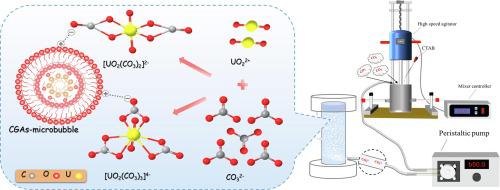当前位置:
X-MOL 学术
›
Miner. Eng.
›
论文详情
Our official English website, www.x-mol.net, welcomes your feedback! (Note: you will need to create a separate account there.)
Removal of uranium (VI) from acidic aqueous solutions by ion flotation using colloidal gas aphrons (CGAs)
Minerals Engineering ( IF 4.9 ) Pub Date : 2024-06-08 , DOI: 10.1016/j.mineng.2024.108766 Zuli Mo , Qingliang Wang , Zhimin Guo , Zhiwu Lei , Fang Hu , Eming Hu , Pengfei Hu
Minerals Engineering ( IF 4.9 ) Pub Date : 2024-06-08 , DOI: 10.1016/j.mineng.2024.108766 Zuli Mo , Qingliang Wang , Zhimin Guo , Zhiwu Lei , Fang Hu , Eming Hu , Pengfei Hu

|
Treatment of uranium-containing wastewater has become an increasingly important research focus with the exploitation and utilization of uranium resources. The introduction of new technologies and continuous updating of existing technologies are the urgent tasks for the treatment of uranium-containing wastewater. Ion flotation is one technology with the potential to address uranium contamination. In this study, the improved ion flotation technique for removing U(VI) from acidic solutions was established by colloidal gas aphrons (CGAs). The CGAs were produced by stirring cetyltrimethylammonium bromide (CTAB) solutions at high speed. Measurements of half-life, gas hold-up, bubble size distribution and zeta potential of CGAs have been performed in this work. In the batch process, as CGAs continued to be added, the uranium removal increased steeply at first then slowly, and finally leveled off. At pH 6, the final uranium removal can reach the highest 99.3 % at an initial uranium concentration of 2.5 mg/L. The effective removal of U(VI) by the CGAs formed by cationic CTAB indicated that U(VI) existed as anionic species under these conditions. It was found that the concentration of carbonate ions in solution increased with the increase of flotation time, which may be caused by the dissolution of carbon dioxide brought in by bubbles. The calculation results of Visual MINTEQ software show that the concentration of carbonate ions generated at pH 6 is sufficient for anionic uranium-carbonate to dominate. In addition, it was found that the size and zeta potential of CGAs all played a significant role in removing U(VI) from the acidic solution.
中文翻译:

使用胶体气体泡沫 (CGA) 通过离子浮选从酸性水溶液中去除铀 (VI)
随着铀资源的开发利用,含铀废水的处理已成为越来越重要的研究热点。新技术的引进和现有技术的不断更新是含铀废水处理的紧迫任务。离子浮选是一种有可能解决铀污染问题的技术。在本研究中,建立了通过胶体气体泡沫 (CGA) 从酸性溶液中去除 U(VI) 的改进离子浮选技术。 CGA 是通过高速搅拌十六烷基三甲基溴化铵 (CTAB) 溶液生产的。这项工作对 CGA 的半衰期、气体滞留量、气泡尺寸分布和 Zeta 电位进行了测量。在间歇过程中,随着CGA的持续添加,铀去除量先急剧增加,然后缓慢增加,最后趋于平稳。在pH 6时,初始铀浓度为2.5 mg/L时,最终铀去除率最高可达99.3%。阳离子 CTAB 形成的 CGA 能有效去除 U(VI),表明在这些条件下 U(VI) 以阴离子形式存在。研究发现,随着浮选时间的增加,溶液中碳酸根离子的浓度增加,这可能是由于气泡带入的二氧化碳溶解所致。 Visual MINTEQ软件的计算结果表明,pH 6时产生的碳酸根离子浓度足以使阴离子碳酸铀占主导地位。此外,我们还发现,CGA 的尺寸和 zeta 电位对于从酸性溶液中去除 U(VI) 都起着重要作用。
更新日期:2024-06-08
中文翻译:

使用胶体气体泡沫 (CGA) 通过离子浮选从酸性水溶液中去除铀 (VI)
随着铀资源的开发利用,含铀废水的处理已成为越来越重要的研究热点。新技术的引进和现有技术的不断更新是含铀废水处理的紧迫任务。离子浮选是一种有可能解决铀污染问题的技术。在本研究中,建立了通过胶体气体泡沫 (CGA) 从酸性溶液中去除 U(VI) 的改进离子浮选技术。 CGA 是通过高速搅拌十六烷基三甲基溴化铵 (CTAB) 溶液生产的。这项工作对 CGA 的半衰期、气体滞留量、气泡尺寸分布和 Zeta 电位进行了测量。在间歇过程中,随着CGA的持续添加,铀去除量先急剧增加,然后缓慢增加,最后趋于平稳。在pH 6时,初始铀浓度为2.5 mg/L时,最终铀去除率最高可达99.3%。阳离子 CTAB 形成的 CGA 能有效去除 U(VI),表明在这些条件下 U(VI) 以阴离子形式存在。研究发现,随着浮选时间的增加,溶液中碳酸根离子的浓度增加,这可能是由于气泡带入的二氧化碳溶解所致。 Visual MINTEQ软件的计算结果表明,pH 6时产生的碳酸根离子浓度足以使阴离子碳酸铀占主导地位。此外,我们还发现,CGA 的尺寸和 zeta 电位对于从酸性溶液中去除 U(VI) 都起着重要作用。






































 京公网安备 11010802027423号
京公网安备 11010802027423号